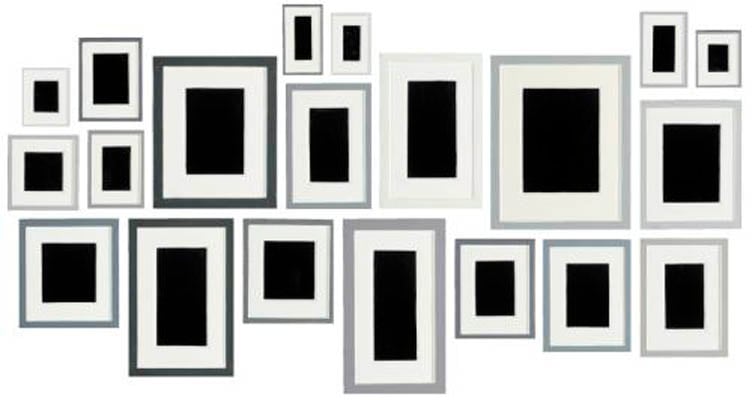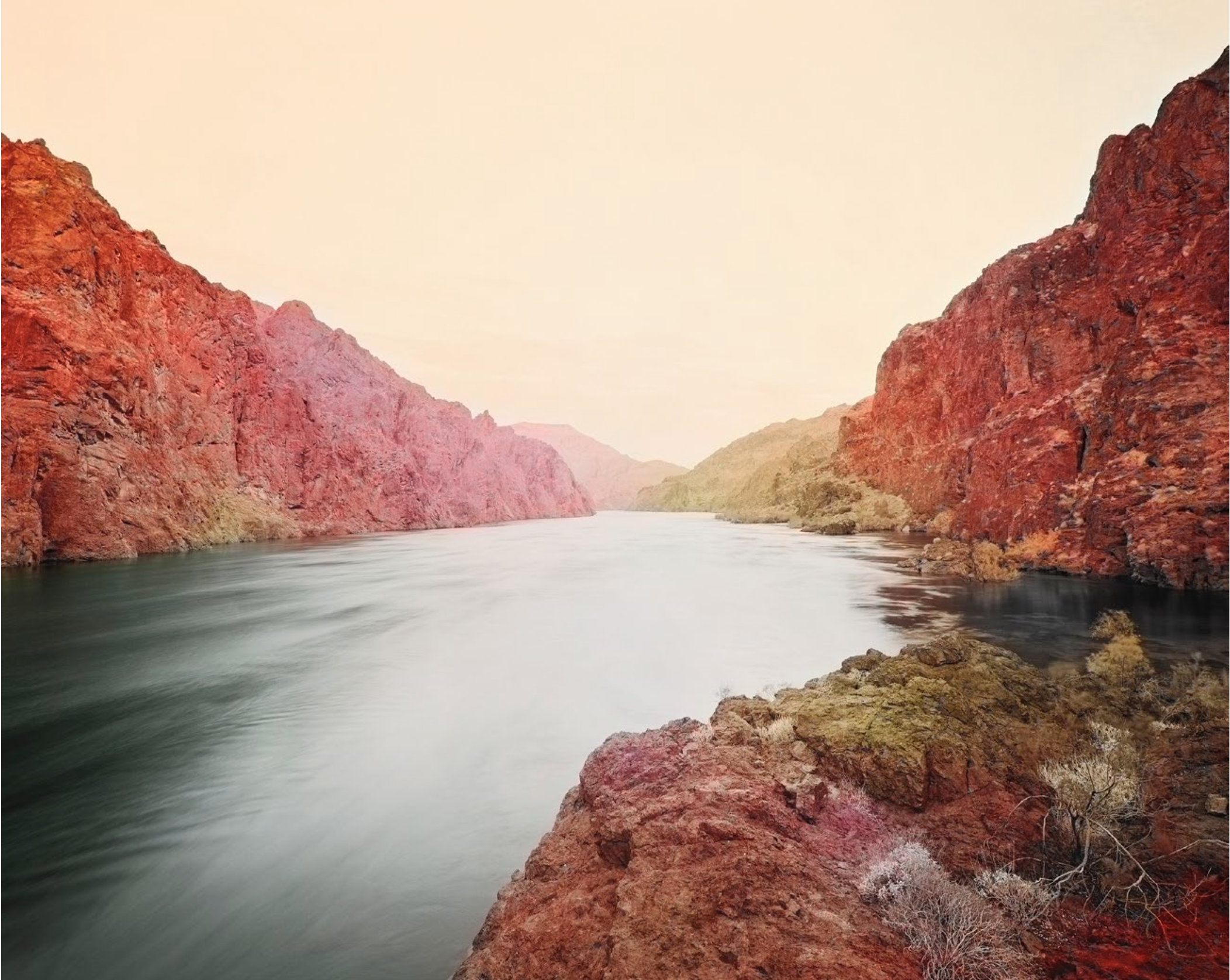The Bedroom
1997 - Installation (Installation)
carpet : 183 x 274 cm; each c-print : 45 x 55 cm
Barbara Bloom
In the 1980’s, while browsing Parisian fleamarkets, Barbara Bloom stumbled into an anonymous watercolor (dating to around 1960) in one of Paris’ fleamarkets, probably a study made by an interior designer for a bedroom. The artist found the image to be typically Parisian. The watercolor, framed under a mat made of cardboard, had color tests on its margin, elements that Bloom discovered when she raised it. These details caught her attention and inspired her to create the installation titled The Bedroom . The work presents several elements related to image: a reproduction of the study, a reproduction of another watercolor contained in the set, and a carpet showing the floor of the depicted room (a detail of the carpet under the bed, and a shadow of the chair represented), as well as dabs of paint also present on the edges of the study. The two prints are hung on the wall, painted in light yellow, like the color of the walls in the study. On the floor, the carpet adds a final touch to the domestic aspect of the installation, also existing as a quasi-abstract expressionist painting. The installation plays upon different levels – the perspective effect on the carpet, aquarelle tests from the margin of the study, as well as “real” elements, each becoming decorative patterns for the piece at large.
Collector Barbara Bloom mixes autobiographical details, fictional narratives, and literary quotes. She arranges images and objects, and at the same time she makes transparent fetishitic qualitites which bind her to her objects and installations. The series entitled “Broken Objects” (2001) features celadon-colored porcelain broken by the artist then “repaired” with gold, according to an ancient Japanese technique. Fractures in the porcelain reveal the object’s fragility and imperfection. Like a precious scar, the porcelain’s fracture tells it’s story. The artist compares herself to a detective who unleashes meaning inside of small details. Bloom belongs to the generation of post-modern artists such as Cindy Shermann, Barbara Kruger, Richard Prince, etc. who analyze visual culture and expose its underlying ideologies. Although her practice is conceptual, it is based on objects that she likes or intrigue her. Through her decorative arrangements she refers to museography and the history of museums (the use of vitrines, wall text, name placards, lighting, etc.) and the way the eye operates inside of this context. Her interest in the question of perception is not only related to the visible and its limits, but also to representation, with particular regard to women’s place in history, which explains why she plays with sentimentality, femininity and elegance in some of her objects. Bloom was Jason Dodge’s professor with whom she shares a sense of metonymy: anecdotes of universal dimensions, the object as a trace, as well as memory and vanity. Barbara Bloom was born in 1951 in Los Angeles. She lives and works in New York.
Colors:
Related works of genres: » american women photographers, » american conceptual artists, » california institute of the arts alumni, » artists from los angeles

© » KADIST
Trisha Donnelly
2007Untitled is a black-and-white photograph of a wave just before it breaks as seen from the distance of an overlook...

© » KADIST
Edgar Arceneaux
2006Untitled (Wheelchair Drawing) is a ten-foot photo transfer of the image of a wheelchair with burning embers in its seat...

© » KADIST
Eleanor Antin
1973Comprised of fifty-one photographic postcards, Antin’s 100 Boots is an epic visual narrative in which 100 black rubber boots stand in for a fictional “hero” making a “trip” from California to New York City...

© » KADIST
Alex Da Corte
2017Slow Graffiti was produced for Da Corte’s exhibition at the Vienna Secession in 2017...

© » KADIST
Matthew Buckingham
2002Matthew Buckingham presents a narrative directly connected with a highly symbolic site in the United States, the Mount Rushmore Memorial*...

© » KADIST
Andrea Bowers
2015Bowers’ Radical Hospitality (2015) is a sculptural contradiction: its red and blue neon letters proclaim the words of the title, signaling openness and generosity, while the barbed wires that encircle the words give another message entirely...

© » KADIST
Allan McCollum
1982In the work titled The Glossies (1980), an affinity for photography manifested itself before McCollum actually began to use photography as a medium...

© » KADIST
Danielle Dean
2016In 2003, Nike released a pair of red and black sneakers (the Dunk Low Pro SB ) that were marketed as “vampire” sneakers...

© » KADIST
Danielle Dean
2015Hexafluorosilicic acid is a type of sodium fluoride waste product that can be found in a large amount of widely available products such as cleaning fluids, toothpaste, rat poison, and drinking water...

© » KADIST
John Baldessari
1997In One Must , an image of a pair of scissors, accompanied by the words of work’s title, poses an ominous question about the relationship between the image and the text...

© » KADIST
Trevor Paglen
2020The Black Canyon Deep Semantic Image Segments by Trevor Paglen merges traditional American landscape photography (sometimes referred as ‘frontier photography’ for sites located in the American West) with artificial intelligence and other technological advances such as computer vision...

© » KADIST
John Baldessari
1991The voids in Baldessari’s painted photographs are simultaneously positive and negative spaces, both additive and subtractive...

© » KADIST
Allen Ruppersberg
1970Untitled (City Limits) is a series of five black-and-white photographs of road signs, specifically the signs demarcating city limits of several small towns in California...

© » KADIST
Glenn Ligon
2000Glenn Ligon’s diptych, Condition Repor t is comprised of two side-by-side prints...

© » KADIST
Trevor Paglen
2020Half Dome Hough Transform by Trevor Paglen merges traditional American landscape photography (sometimes referred as ‘frontier photography’ for sites located in the American West) with artificial intelligence and other technological advances such as computer vision...

© » KADIST
Brian Bress
2013Blindseye Arranger (Max) (2013) features a greyscale arrangement of rudimentary shapes layered atop one another like a dense cluster of wood block prints, the juxtaposition of sharp lines and acute angles creating an abstracted field of rectangular and triangulated forms composed as if in a cubist landscape...




